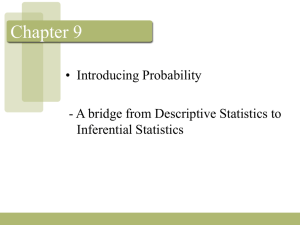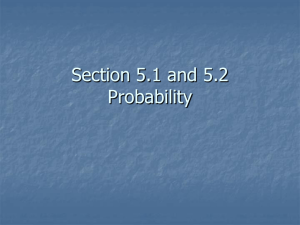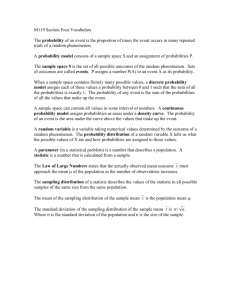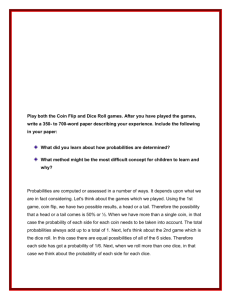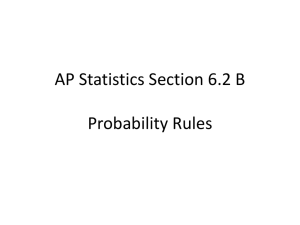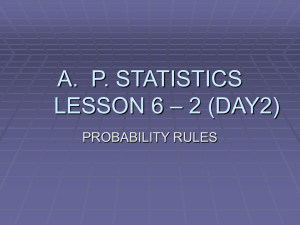Probability Models
advertisement
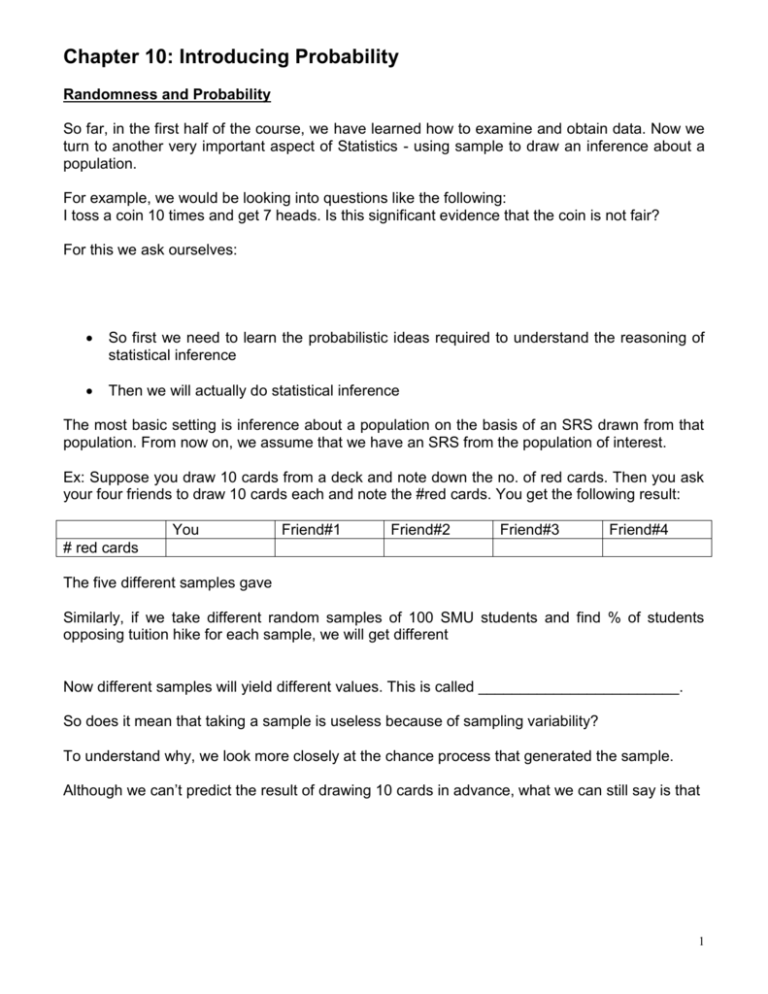
Chapter 10: Introducing Probability
Randomness and Probability
So far, in the first half of the course, we have learned how to examine and obtain data. Now we
turn to another very important aspect of Statistics - using sample to draw an inference about a
population.
For example, we would be looking into questions like the following:
I toss a coin 10 times and get 7 heads. Is this significant evidence that the coin is not fair?
For this we ask ourselves:
So first we need to learn the probabilistic ideas required to understand the reasoning of
statistical inference
Then we will actually do statistical inference
The most basic setting is inference about a population on the basis of an SRS drawn from that
population. From now on, we assume that we have an SRS from the population of interest.
Ex: Suppose you draw 10 cards from a deck and note down the no. of red cards. Then you ask
your four friends to draw 10 cards each and note the #red cards. You get the following result:
You
Friend#1
Friend#2
Friend#3
Friend#4
# red cards
The five different samples gave
Similarly, if we take different random samples of 100 SMU students and find % of students
opposing tuition hike for each sample, we will get different
Now different samples will yield different values. This is called ________________________.
So does it mean that taking a sample is useless because of sampling variability?
To understand why, we look more closely at the chance process that generated the sample.
Although we can’t predict the result of drawing 10 cards in advance, what we can still say is that
1
This is the idea of a random phenomenon:
Note that the word “random” (as we use it in Statistics) is not a synonym for “haphazard”.
The probability of any outcome of a random phenomenon is
As we go further in exploring random phenomena, we need to keep in mind:
We must have a long series of independent trials.
Ex. If we toss a fair coin 10 times and get 10 heads, the probability of getting a head in the next
trial is
The idea of probability is empirical.
Probability Models
Now let us try to model a random phenomenon. For example, consider again coin tossing (fair
coin).
We don’t know the outcome of any tossing in advance but we can say the following:
Possible outcomes:
Probability of each outcome:
These two make up the probability model of this random phenomenon.
A probability model consists of
(1) sample space (S) –
(2) probability for each outcome
An event is an outcome or set of outcomes of a random phenomenon.
Event = subset of the sample space S.
Ex: If we roll a dice once the sample space is
Some possible events are:
Ex: Indicate the sample space associated with each of following random phenomenon.
(a) When you try to log on to Online Services at the Registrar’s website, you are able to access
it (P) if the server is not at its full capacity, otherwise you are not able to access it (F). Suppose
you try to log on 2 times on the first day of classes and record # Ps.
2
(b) You record the sequence of P and F in your 2 attempts to log on to Online Services in (a).
(c) You ask a randomly chosen Stat 2331 student whether he/she likes or hates the
instructor.
(d) Subway invents a new sandwich and feeds it to Jared Foegle whose initial weight is 300lbs.
Subway notes Jared’s weight in the next month.
(e) Jared’s weight gain after eating the new Subway sandwich.
(f) # beers one can drink before he/she passes out.
Rules of Probabilities
Notation: Pr(A) = probability of event A
(Rule 1) The probability of any event A satisfies:
E.g. If we roll a fair dice once, Pr(getting 6) =
(Rule 2) If S is the sample space then
(Rule 3) Addition Rule for Disjoint Events
Two events, say A and B, are disjoint if they have no outcomes in common. So they cannot
occur simultaneously.
If events A and B are disjoint then
E.g. Pr(getting 6 or 2) =
(Rule 4) Complement Rule
The complement of any event A, written as Ac, is the event A does not occur.
E.g. Pr(not getting 6) =
3
Ex: The following is the distribution of the blood type of a randomly chosen African American:
Blood Type
Probability
O
0.48
A
0.27
B
0.20
AB
a)
What is the probability of type AB blood in African Americans?
b)
What is the probability that a randomly chosen African American will not have type O
blood?
c)
Maria has type B blood. She can safely receive blood transfusions from people with
blood types O and B. What is the probability that a randomly chosen African American
can donate blood to Maria?
Discrete Probability Models
A probability model with a finite sample space is called discrete.
Assigning Probabilities in a Finite Sample Space:
Assign a probability to each individual (unique) outcome so that the sum of the
probabilities is 1.
The probability of any event is the sum of the probabilities of the outcomes making up the
event.
Ex: Roll 2 dice and record the up-faces in order.
a) What does the sample space look like?
b) What probabilities get assigned to each of the outcomes?
c)
Let the event A = “Roll a 7”. What outcomes does the event A consist of?
d) What is Pr(A)?
4
Definition: A random variable, X, is a variable whose numerical value depends on the outcome
of a random phenomenon.
E.g. Consider the random phenomenon: Tossing a coin 10 times.
One random variable associated with it is
Definition: The distribution of a random variable, X, is called a probability distribution. It tells
the possible values X can take, and
the probabilities of these values occurring.
Ex: Tossing three coins. We are interested in the total # of heads.
Probability Model
The random variable of interest is
The probability distribution of X is:
Pr(0 < X 3) =
Continuous Probability Models
A continuous probability model assigns probabilities as areas under a density curve and
above any range of values is the probability of an outcome in that range.
Assigning Probabilities in an Infinite Sample Space (intervals of outcomes):
Consider the random variable X representing the lifetime of a battery. What are the possible
values that X can take?
We see that the # of possible outcomes is
How can we assign probabilities to events such as {1 < X < 3}?
It is not possible to count the total # of outcomes that make up this event and add their
probabilities because
We use a new way of assigning probabilities to the intervals of outcomes like the above – use
areas under the density curves.
5
Recall density curves from Chapter 3:
The area under a density curve in any given range of values (interval) gives the proportion of
observations that fall in that range. We assign this proportion as the
Ex: Suppose the heights of female students in SMU had the normal distribution with mean =
168cm and standard deviation = 5cm. Let X represents the height. What is the probability that
a female student’s height fell between 160 and 170?
6
Ex: Another density curve - Uniform distribution.
A DART train comes every 10 minutes. Suppose you are waiting for a DART train at the
Mockingbird Station. Your waiting time X is a random variable that can vary from
______________. The density curve of X then looks like
a) What is the height of the above density curve?
Find the following probabilities:
b) Probability that you will wait less than or equal to 1 minute.
c) Probability that you will wait more than 3 minutes.
d) Probability that you will wait less than or equal to 1 minute or more than 3 minutes.
7

